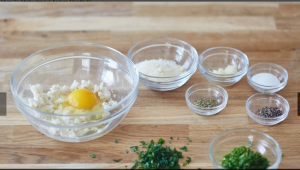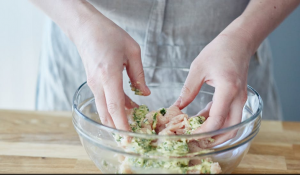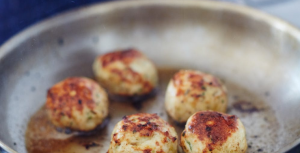Recipe of the week
 How To Make Juicy Chicken Meatballs
How To Make Juicy Chicken Meatballs
By Meghan Splawn
All the qualities we admire in a classic meatball — the crisp brown exterior, the tender interior, herby and fragrant with garlic — can be found in chicken meatballs, too. Juicy chicken meatballs.
By seeking out ingredients that add fat to what some consider a meat too dry for meatballs, we add both flavor and moisture to a lighter, cheaper meatball. Don’t believe me? Come along as I show you have to make a better meatball with ground chicken, so that you can have juicy meatballs any night of the week.
Chicken Meatballs Are Actually Really Awesome
Juicy chicken meatballs utilize ground chicken, a cost-effective alternative to the beef, pork, or veal in traditional meatball recipes. And of course, there are the rare occasions when we’ve got ground chicken on hand already and a meatball craving strikes — no need to run out for ingredients with this recipe.
Chicken meatballs are even easier to work into a dinner plan than more traditional meatballs; spaghetti and meatballs really is just the beginning. Chicken meatballs can be baked in teriyaki sauce and served over rice for a twist on teriyaki takeout, or buoyed in chicken broth for a modern take on chicken noodle soup.
Sure, chicken meatballs require a little more finesse to prevent dry meatballs, but by selecting the right kind of ground chicken and using a classic meatball technique, we can all but guarantee these meatballs will be juicy no matter how they are cooked.
For Juicy Chicken Meatballs, Use Ground Thighs
Choose ground chicken (mixture of white and dark meat) or ground chicken thighs (if you can find it). All chicken breast might sound good if that’s the cut of chicken you normally buy, but if you are looking for juicy meatballs, make sure at least a portion of the meat you use is dark. Many supermarkets carry just ground chicken — white and dark together — in the poultry case, but you can ask your butcher to grind chicken thighs for your meatballs too.
What the Heck Is Panade, and Why Do Your Meatballs Need It?
A panade is a mixture of starch — usually bread pieces or breadcrumbs — with liquid. Panades are most often made with milk, buttermilk, or stock; they help moisten ground meat and keep it from overcooking. For juicy chicken meatballs, use a mixture of fresh breadcrumbs and whole milk. Mixing seasonings into a panade, rather than directly into the ground meat, means there is no overmixing, which leads to more tender, juicy meatballs.
The Best Ways (Yes Ways!) to Cook Chicken Meatballs
Most classic meatballs are pan-seared and simmered in red sauce before being served with spaghetti or in meatballs subs. This was indeed our favorite way to cook these chicken meatballs too, as it produced the juiciest meatballs. Sometimes, though, you want to use the oven or you want to slow cook them to have for dinner after work.
Here are six other cooking methods you can use to get these juicy chicken meatballs on the table. You’ll know the meatballs are cooked when they register 165°F on an instant-read thermometer.
Oven roasted: Bake on a parchment-lined rimmed baking sheet at 400°F for 12 to 15 minutes.
In a mini-muffin pan: Lightly grease a mini-muffin tin and place one meatball into each well. Bake at 400°F for 12 to 15 minutes.
Stovetop without sauce: Heat a thin film of olive oil in a large skillet over medium heat until shimmering. Add the meatballs, making sure not to crowd the pan. Cook, turning every minute or so, until browned on all sides, 10 to 12 minutes total.
Browned under the broiler, then simmered: Place the meatballs on a greased rimmed baking sheet and broil on high for five minutes. Transfer to a pot with sauce and simmer with sauce for five to seven minutes.
Slow cooker with sauce: Pour sauce into a slow cooker. Submerge the raw meatballs in the sauce. Cover and cook on the LOW setting for two hours.
Cooked in broth: Bring your soup or broth to a boil. Add the raw meatballs, reduce the heat to a simmer, and cook for 10 to 12 minutes.
How To Make Juicy Chicken Meatballs
Makes 24 meatballs; 4 to 6 servings
What You Need
Ingredients
1 slice white sandwich bread (such as Pepperidge Farm Farmhouse Hearty White bread) crusts removed and torn into small pieces
3 tablespoons whole milk
1/2 cup finely grated Parmesan cheese
1 large egg
3 tablespoons finely chopped fresh chives
2 tablespoons finely chopped fresh parsley leaves
1 large garlic clove, minced
1/2 teaspoon dried oregano
1/2 teaspoon kosher salt
1/4 teaspoon freshly ground black pepper
1 pound ground chicken
2 tablespoons olive oil
2 cups tomato or marinara sauce
Equipment
Measuring cups and spoons
Large bowl
Whisk
Chef’s knife
Rimmed baking sheet
Large frying pan
Straight-sided large skillet or Dutch oven
Instructions
Make the panade: Combine the bread and milk in a large bowl. Let sit until the bread is saturated, 2 to 3 minutes.
Add the seasoning: Add the Parmesan, egg, chives, parsley, garlic, oregano, salt, and pepper. Whisk until well-combined.
Mix in the chicken: Add the ground chicken and mix with your fingertips until just combined. Do not mash the meat or overwork the mixture, or else the meatballs will be dry and tough.
Form into meatballs: Form the mixture into 1 1/2-inch meatballs (about 2 tablespoons each) and place on a rimmed baking sheet.
Brown the meatballs: Heat the oil in a large frying pan over medium heat until shimmering. Add the meatballs, making sure not to crowd the pan and working in batches if needed. Cook, turning every minute, until browned all over, 3 to 4 minutes. Transfer to a large skillet with high sides or Dutch oven.
Simmer in sauce: Add the sauce, stir to combine, and bring to a simmer over medium heat. Simmer until cooked through and an instant-read thermometer registers 165°F, 5 to 7 minutes.
Serve: Serve the meatballs and sauce over pasta, on polenta, or in a hoagie roll as a meatball sub.
Recipe Notes
Make ahead and freezing: Make meat mixture the day before, form into meatballs, and place on the parchment-lined baking sheet. Cover and refrigerate until ready to cook. Alternatively, freeze until solid, then transfer to a resealable freezer bag and freeze for up to 2 months. You do not need to thaw before cooking, but the meatballs will need additional cooking time.
Storage: Leftovers can be stored in an airtight container in the refrigerator for up to 4 days.
All IMAGES:
(Image credit: Lauren Volo)
For more on this story and video go to: http://www.thekitchn.com/how-to-make-juicy-chicken-meatballs-242658?utm_source=RSS&utm_medium=feed&utm_campaign=Feed%3A+apartmenttherapy%2Fthekitchn+%28TK+Channel%3A+Main%29










